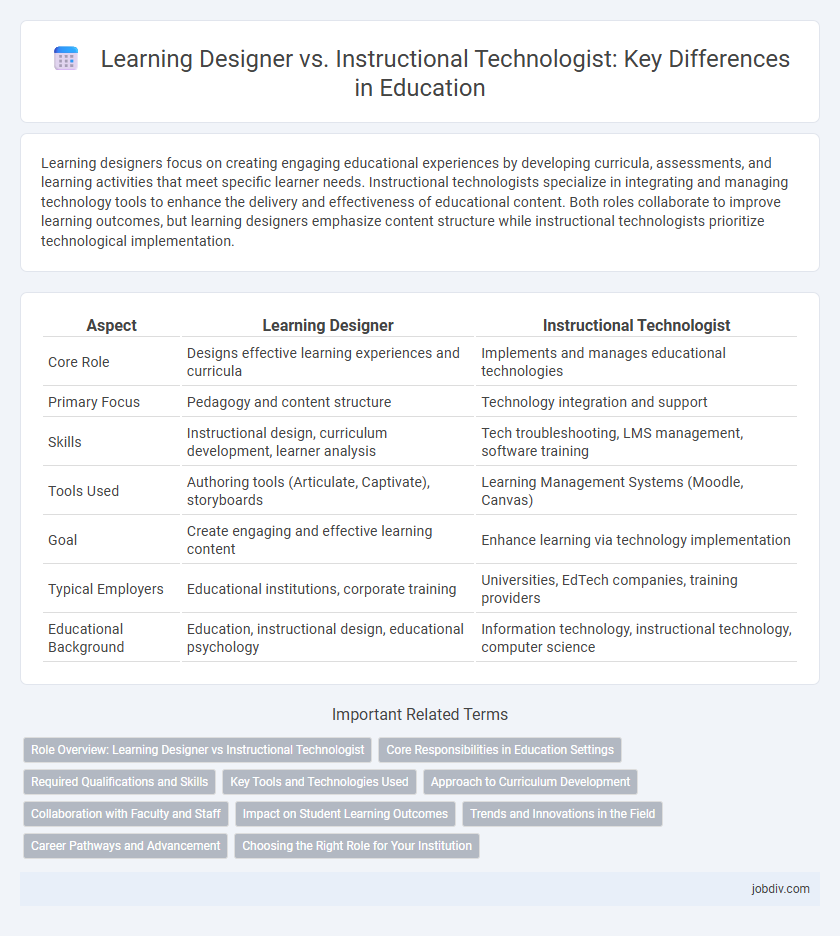Learning designers focus on creating engaging educational experiences by developing curricula, assessments, and learning activities that meet specific learner needs. Instructional technologists specialize in integrating and managing technology tools to enhance the delivery and effectiveness of educational content. Both roles collaborate to improve learning outcomes, but learning designers emphasize content structure while instructional technologists prioritize technological implementation.
Table of Comparison
| Aspect | Learning Designer | Instructional Technologist |
|---|---|---|
| Core Role | Designs effective learning experiences and curricula | Implements and manages educational technologies |
| Primary Focus | Pedagogy and content structure | Technology integration and support |
| Skills | Instructional design, curriculum development, learner analysis | Tech troubleshooting, LMS management, software training |
| Tools Used | Authoring tools (Articulate, Captivate), storyboards | Learning Management Systems (Moodle, Canvas) |
| Goal | Create engaging and effective learning content | Enhance learning via technology implementation |
| Typical Employers | Educational institutions, corporate training | Universities, EdTech companies, training providers |
| Educational Background | Education, instructional design, educational psychology | Information technology, instructional technology, computer science |
Role Overview: Learning Designer vs Instructional Technologist
Learning Designers focus on creating engaging and effective educational content by applying learning theories and instructional strategies to meet diverse learner needs. Instructional Technologists specialize in integrating technology tools and platforms to enhance the delivery and accessibility of educational programs. Both roles collaborate to optimize learning experiences, with Learning Designers emphasizing pedagogy and Instructional Technologists ensuring technical implementation and support.
Core Responsibilities in Education Settings
Learning Designers develop curriculum frameworks and create engaging educational materials that align with pedagogical goals and learner outcomes, emphasizing instructional strategies and content structure. Instructional Technologists focus on integrating and optimizing technology tools, platforms, and multimedia resources to enhance the delivery and accessibility of educational programs. Both roles collaborate to ensure seamless implementation of educational technology and effective course design that supports diverse learning environments.
Required Qualifications and Skills
Learning Designers typically require a background in education, instructional design, or psychology, with strong skills in curriculum development, learner analysis, and assessment strategies. Instructional Technologists often need expertise in educational technology, software development, and multimedia tools, alongside skills in technology integration, troubleshooting, and user training. Both roles benefit from proficiency in project management, data analysis, and communication to enhance learning experiences through innovative solutions.
Key Tools and Technologies Used
Learning Designers primarily utilize authoring tools like Articulate Storyline and Adobe Captivate to create engaging e-learning content, while Instructional Technologists focus on integrating Learning Management Systems (LMS) such as Moodle and Blackboard to deliver and manage educational programs. Both professionals leverage multimedia tools including Camtasia and video editing software, but Instructional Technologists often have deeper expertise in educational software platforms, data analytics tools, and emerging technologies like AI-driven adaptive learning systems. Mastery of SCORM and xAPI standards is crucial for Learning Designers to ensure content compatibility, whereas Instructional Technologists emphasize technical infrastructure and system interoperability.
Approach to Curriculum Development
Learning Designers prioritize a learner-centered approach, integrating educational theories and user experience principles to create engaging and effective curricula. Instructional Technologists emphasize the application of technological tools and platforms to optimize content delivery and facilitate interactive learning environments. Both roles collaborate to enhance curriculum development but differ in focusing primarily on pedagogical strategy versus technology integration.
Collaboration with Faculty and Staff
Learning Designers collaborate closely with faculty and staff to develop curriculum that aligns with educational goals and enhances student engagement using evidence-based instructional strategies. Instructional Technologists support these efforts by integrating advanced educational technologies, ensuring seamless use of digital tools and platforms that complement pedagogical objectives. Joint efforts between these roles foster innovative learning environments, improve course design, and streamline faculty adoption of technology-enhanced teaching methods.
Impact on Student Learning Outcomes
Learning Designers focus on creating effective, research-based curriculum and learning experiences to enhance student engagement and comprehension, directly improving learning outcomes. Instructional Technologists integrate and manage educational technologies that support these designs, enabling personalized and scalable learning environments. Their combined efforts optimize instructional quality and accessibility, promoting higher academic achievement and retention rates.
Trends and Innovations in the Field
Learning designers integrate emerging trends such as adaptive learning technologies and AI-driven personalization to create engaging educational experiences, while instructional technologists focus on implementing and optimizing these digital tools within learning management systems and virtual environments. Both roles leverage innovations like augmented reality (AR), virtual reality (VR), and data analytics to enhance learner engagement and outcomes. The increasing emphasis on mobile learning and microlearning reflects a shift toward flexible, learner-centered education models driven by collaboration between learning designers and instructional technologists.
Career Pathways and Advancement
Learning Designers concentrate on curriculum development and pedagogical strategies, often advancing into roles such as Senior Learning Designer or Curriculum Manager, leveraging expertise in educational theory and content creation. Instructional Technologists specialize in integrating technology into learning environments, progressing towards positions like Technology Integration Specialist or Director of Instructional Technology by mastering digital tools and system management. Both career pathways offer opportunities for leadership and innovation within educational institutions, with advancement driven by proficiency in design principles or technical acumen respectively.
Choosing the Right Role for Your Institution
Learning designers specialize in curriculum development and pedagogical strategies to enhance student engagement and learning outcomes, while instructional technologists focus on integrating digital tools and systems to support education delivery. Institutions must evaluate their specific needs--whether prioritizing innovative course design or technology implementation--to select the role that best aligns with their instructional goals. Collaboration between learning designers and instructional technologists often maximizes educational effectiveness by combining expertise in pedagogy and technology.
Learning Designer vs Instructional Technologist Infographic

 jobdiv.com
jobdiv.com